California’s “Top Two” Primary System
Steven L. Taylor
·
Wednesday, June 6, 2012
·
21 comments
Matthew Shugart shares an ballot example from CA’s primary election:
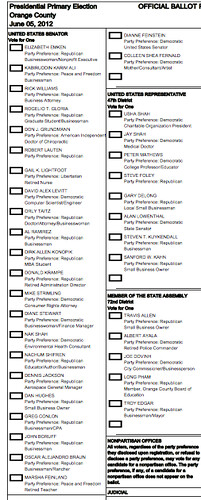
For a partial close-up, click here.
The results:
Dianne Feinstein won 49.3% of the vote and will face off against Republican Elizabeth Emken, who won 12.5% of the vote.

About Steven L. Taylor
Steven L. Taylor is a Professor of Political Science and a College of Arts and Sciences Dean. His main areas of expertise include parties, elections, and the institutional design of democracies. His most recent book is the co-authored
A Different Democracy: American Government in a 31-Country Perspective. He earned his Ph.D. from the University of Texas and his BA from the University of California, Irvine. He has been blogging since 2003 (originally at the now defunct Poliblog).
Follow Steven on
Twitter


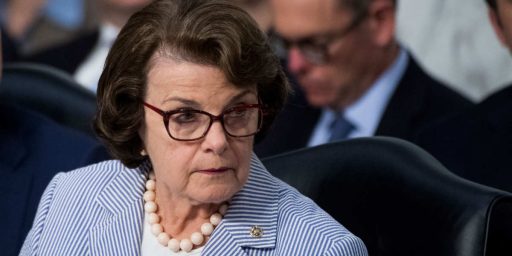
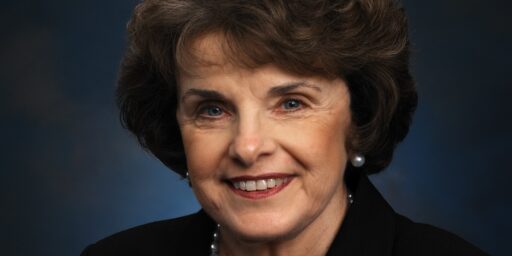
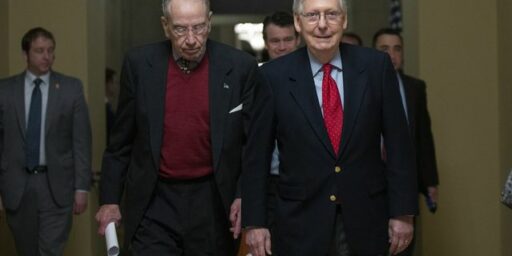
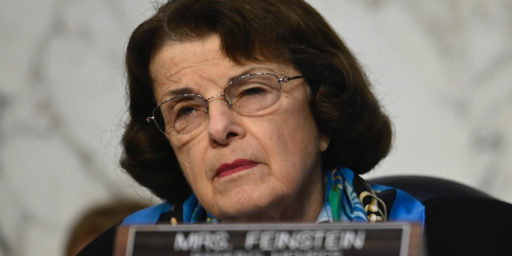
What’s it going to take to get instant runoffs in this country?
Hmm, poor ballot design with too many candidates to choose from (24!), and in the end, it looks like the same two people who probably would have moved on to the general election under the old rules have done so here, at least for the senate race.
So, effectively all California has done here is eliminate the presence of third party candidates in (at least statewide) races. Don’t think that was the voters’ intention, but most of California governance is a sad dance with unexpected consequences.
Timothy,
I’m still not sold on the idea of instant runoffs
@Doug Mataconis:
I’ll bite: why?
Steven,
Mostly because I’m not convinced that it can work logistically, or that it’s needed. Outside of the South, most states have laws that say that the person who gets the most votes in a primary wins. Why do we need to change that?
@Doug Mataconis:
Australia uses it to elect the lower house–so logistics aren’t an issue.
Whether it is desirable in a given context is a different discussion.
@Steven L. Taylor:
There’s a number of weird outcomes that can occur in IRV elections, the most disturbing of which is that under IRV it’s possible to lose because too many people voted for you:
http://en.wikipedia.org/wiki/Monotonicity_criterion
Next action I predict happens: Orly Taitz will sue everyone for election fraud because she didn’t win.
I’m not quite sold on ‘instant runoffs either.
Oakland, in 2010, elected it’s current mayor (Jean Quan) in a Ranked Choice system.
What happened was Don Perata was selected by 35% of voters as their first choice while Jean Quan was chosen by only 24% as their first choice, however there being no clear majority winner, the ranked choice system kicked in and, long story short, Quan won.
Quan has turned out to be – because of general incompetence and some bad luck – one of the worst mayors in modern Oakland history, and this covers a lot of ground.
@al-Ameda: Of course, one presumes if Quan won the IRV he would have won in a normal run off as well.
@Steven L. Taylor:
I find the instant runoff alternatives to be interesting, but surely all that any of them will do is eliminate the cost of a runoff election, they will not result in better candidates or better results.
@al-Ameda:
Actually, what they ensure is that the electorate the votes in the first round is the same as that votes in the second.
A major problem with two-step run-offs is that the electorate in step one and in step are not the same (and often is smaller in step two–especially in primaries).
(And no electoral system can guarantee good office holders).
@al-Ameda:
BTW, I would argue that the “results” one should expect from electoral rules have to do with how well those rules reflect the actual preferences of the electorate. As such, IRV does a better job of that than does first past the post.
This is not t say that it is electoral nirvana.
Regardless, as I noted, electoral rules cannot guarantee good candidates nor can they guarantee good officeholders . They can, however, shape candidate, party, and voter behavior and, again, shape how well voter preferences are recorded and applied.
No voting system can reflect the actual preferences of the electorate:
http://en.wikipedia.org/wiki/Arrow's_impossibility_theorem
@Stormy Dragon:
“better job”
Lest we forget. California Primary June 5, 1968.
http://en.wikipedia.org/wiki/File:Rfk_assassination.jpg
@ernieyeball: Correction. The 1968 California was held on June 4. Robert Kennedy was shot just after midnight June 5 PST.
@Steven L. Taylor:
As I mentioned earlier, I don’t think it does do a better job. When IRV breaks down (which according to current research is believed to occur in roughly 5-15% of elections), it does so in ways that are highly chaotic.
Steven,
In terms of the real effects of the “Top Two” primary process in California, I think you focused on the wrong race. Given than Senate seats are state wide, and we live in a more or less two party system its difficult to imagine many cases where you would end up with a race between the two parties — at least in a state that has as mixed a population as California.
Looking to more local positions — in particular races for House seats — things read a bit different: nearly 30 congressional races in California will feature an intra-party battle. (Source: the transcript is coming, here’s the link to the audio story: http://www.npr.org/2012/06/06/154456400/new-primary-system-shakes-up-california-elections
While I realize that this time didn’t see a lot of third party candidates making it to the final round, the possibility of getting to choose between a Conservative or Liberal Democrat or Republican (and the need for the candidates to reach out to followers of the other party) is, I hope, a good thing for getting back to a more “sane” house of representatives.
@mattb:
Correction — nearly 30 statewide races will be an intra-party competition. Of those races, approximately 7 will be for house seats.
The transcript is now up at NPR…